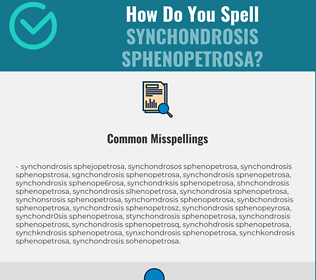SYNCHONDROSIS SPHENOPETROSA Meaning and
Definition
-
Synchondrosis sphenopetrosa refers to a specific type of joint found in the human skull. It is a synchondrosis, which is a type of joint where bones are united by hyaline cartilage, allowing for slight movement. The term "sphenopetrosa" refers to the specific bones involved in this joint, namely the sphenoid bone and the petrous part of the temporal bone.
The synchondrosis sphenopetrosa is located between the greater wing of the sphenoid bone and the petrous part of the temporal bone. It is classified as a primary cartilaginous joint since it is present at birth and is responsible for the growth and development of the skull during childhood.
This joint is essential for the proper functioning of the cranial base and helps to maintain the structural integrity of the skull. It allows for minor movement between the bones, which is important for accommodating the growth of the brain and skull in young children.
The synchondrosis sphenopetrosa has a cartilaginous disc between the sphenoid and temporal bones, which is gradually replaced by bone as growth and development progress. Once the bones fuse, usually in adolescence or early adulthood, the joint ossifies, becoming a solid, immovable structure.
In summary, the synchondrosis sphenopetrosa is a primary cartilaginous joint that connects the sphenoid and temporal bones in the skull. It plays a crucial role in skull growth and development during childhood.
-
Sphenopetrous or sphenopetrosal s., fibrocartilage filling the sphenopetrosal fissure.
A practical medical dictionary. By Stedman, Thomas Lathrop. Published 1920.
Common Misspellings for SYNCHONDROSIS SPHENOPETROSA
- s ynchondrosis sphenopetrosa
- sy nchondrosis sphenopetrosa
- syn chondrosis sphenopetrosa
- sync hondrosis sphenopetrosa
- synch ondrosis sphenopetrosa
- syncho ndrosis sphenopetrosa
- synchon drosis sphenopetrosa
- synchond rosis sphenopetrosa
- synchondr osis sphenopetrosa
- synchondro sis sphenopetrosa
- synchondros is sphenopetrosa
- synchondrosi s sphenopetrosa
- synchondrosis sph enopetrosa
- synchondrosis sphe nopetrosa
- synchondrosis sphen opetrosa
- synchondrosis sphenope trosa
- synchondrosis sphenopet rosa
- synchondrosis sphenopetr osa
- synchondrosis sphenopetro sa
- synchondrosis sphenopetros a
Etymology of SYNCHONDROSIS SPHENOPETROSA
The word "synchondrosis sphenopetrosa" is a compound term derived from Greek and Latin roots. Here is the breakdown:
1. Synchondrosis: This term originates from the Greek words "syn" meaning "together" and "chondros" meaning "cartilage". Synchondrosis refers to a type of joint where bones are connected by hyaline cartilage.
2. Spheno-: This prefix comes from the Greek word "sphén" meaning "wedge". It is often used to denote anything related to the sphenoid bone.
3. -petrosa: This suffix is derived from the Latin word "petrosus" meaning "rock-like" or "stony". It is usually used to describe something relating to the petrous part of the temporal bone.
Infographic
Add the infographic to your website:





